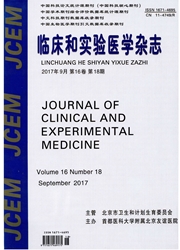

 中文摘要:
中文摘要:
目的 阐明应用聚乙二醇化干扰素治疗慢性丙型肝炎(CHC)引起抑郁的流行病学特征。方法 采用Beck抑郁自评量表,监测、评估研究对象在接受聚乙二醇化干扰素治疗过程中抑郁情绪的变化情况和严重程度。结果在聚乙二醇化干扰素治疗过程中(48周),84%的患者未出现抑郁症状;9.4%、3.5%、3.1%的患者分别曾经处于临界抑郁状态、轻度抑郁状态、中重度抑郁状态。抑郁发作在干扰素治疗第20~36周;抑郁状态从无发展至轻度中位时间是14周,抑郁加重的中位时间是6周。有、无抑郁状态的CHC患者在年龄、婚姻状况、受教育程度、家庭月均收入以及饮酒情况等人口学特征均具有统计学差异(P〈0.05)。其中,年龄高(OR=1.11;P=0.014)、离异/丧偶婚姻状况(OR=11.42;P=0.025)是抑郁的危险因素;教育程度高(OR=0.14-0.54;P=0.048)是抑郁保护因素。结论 在聚乙二醇化干扰素治疗CHC过程中应关注抑郁高危患者,并在治疗的中后期应加强对抑郁状态的监测。
 英文摘要:
英文摘要:
Objective The aim of the study was to evaluate the epidemiological characteristics of depression in CHC patients on pegylated interferon therapy. Methods We investigated CHC patients using the Beck Depression Inventory at baseline,during and after the pegylated interferon therapy. Results During the pegylated interferon therapy( 48 weeks),eighty- four of the 128 patients did not develop depression( 84%). The percentage of critical depression,mild depression,and moderate to severe depression were 9. 4%,3. 5%,and 3. 1%,respectively. The onset of depression ranged from the first 20 to 36 weeks of the therapy,with a median time to developed recession being 14 weeks and a median time to worsenbeing6 weeks. There was significant difference between CHC patients with and without depression in age,marital status,education level,family annual income,and drinking status( P〈0. 05). Higher age( OR = 1. 11; P = 0. 014) and divorced / windowed marital status( OR = 11. 42; P = 0. 025) were the risk factors of depression. Education level( OR = 0. 14- 0. 54; P = 0. 048) was the protect factors of depression. Conclusion More care should be paid to CHC patients with high risk of depression,especially during the mid and late course of the pegylated interferon therapy.
 同期刊论文项目
同期刊论文项目
 同项目期刊论文
同项目期刊论文
 期刊信息
期刊信息
